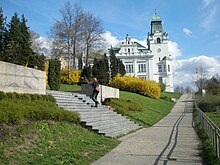Town Hall (Slezská Ostrava)
The Slezská Ostrava Town Hall ( Slezskoostravská radnice ) in the center of the city of Ostrava is one of the city's landmarks. It is located on the right bank of the Ostravice , below the confluence of the Lučina , at the address Těšínská 138.
history
The community building, rebuilt in neo-baroque style in 1897, was no longer sufficient for representative purposes. That is why the construction of the new town hall was decided under the leadership of Mayor Jan Poppe. It was built on a plot of land next to the old town hall in Zámostí.
In early 1910, the city held an architectural competition for the town hall. Third place went to a project by Antonín Papež in the classicism style, the second was the proposal by the architect Viktorin Šulc from Pilsen . His project "Hanna" was kept in the form of the historicizing architectural style.
The construction of the new town hall took place in 1911–1913 according to modified plans, in which, in addition to Šulc, the head of the building department at the municipal office Jaroslav Volenec, his assistant František Doležel and the builder Julius Vysloužil took part. The design of the town hall is a combination of neo-renaissance forms with other historical architectural styles. There are also elements of Art Nouveau here , especially inside. The main staircase to the first floor and the hall there are typical examples.
The valuable parts include the plate inscriptions in the entrance staircase, the main staircase with lighting fixtures and, above all, the representation hall with richly decorated chandeliers. Although the town hall was not a revolutionary architectural work, its exterior and scale formed a picturesque and correspondingly balanced unit with the surrounding houses. Around 1950 subsidence appeared as an impact of coal mining in the entire area. The urban planning intention to lead a north-south main road below the town hall on the right bank of the Ostravice also contributed to the destruction of the fairly new development in Zámostí . This resulted in a redesign of this part of Slezská Ostrava.
Further use
The town hall was not only the seat of the municipal office of Polish Ostrau / Polská Ostrava and the later city office of Silesian Ostrau / Slezská Ostrava. From October 1918 it became temporarily the center of the new Czechoslovak authorities for Cieszyn Silesia .
In 1941 Silesian Ostrava was annexed to Moravská Ostrava and after the Second World War the city was renamed Ostrava. Since then, the city hall for the Slezská Ostrava district has been working in the town hall, which is primarily using the building to represent this district.
At the time of its construction, the building was also an expression of modernization tendencies and activities of the self-government of the market town of Polská Ostrava, which was renamed Slezská Ostrava in 1919 and was given the rank of town in 1920, after the final confirmation of its affiliation to the new Czechoslovak Republic. The town hall building still reminds of these efforts today.
Individual evidence
- ↑ Martin Strakoš. Radnice Slezské Ostravy jako vychýlený svorník mezi tradicí a moderností. Slezská Ostrava: SPOK - spolek pro ostravskou culture, 2008. ISBN 978-80-904096-0-6 .
Coordinates: 49 ° 50 ′ 14 " N , 18 ° 17 ′ 53" E



